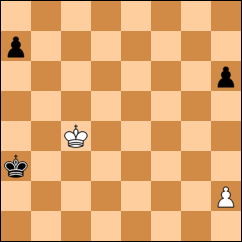BTM Draw
Section B.2.
David Blundell (Gales)
wKc4,Ph2/bKa3,Pa7,h6
I 1…Ka4 2.h3z/i Ka5 3.Kc5z Ka6 4.Kc6z/ii Ka5 5.Kc5z a6 6.h4/iii h5 7.Kc4 Kb6 8.Kb4 Kc6 9.Ka5 Kd6 10.Kxa6 Ke6 11.Kb5 Kf5 12.Kc4 Kg4 13.Kd3 Kxh4 14.Ke2 Kg3 15.Kf1 and draws.
II 1…Kb2 2.Kb5 Kc3 3.Ka6 Kd3 4.Kxa7 Ke3 5.Kb6 Kf3 6.Kc5 Kg2 7.h4/iv Kg3 8.h5 Kg4 9.Kd4(c4) Kxh5 10.Ke3 Kg4 11.Kf2 draw.
(i) And not the plausible 2.Kc5? since after 2…h5 3.Kc4 h4 the White pawn is confined to h2/h3 and Black is able to advance the a pawn, e.g. 4.h3 a5 5.Kc3 Kb5 6.Kb3 Kc5 7.Ka4 Kd5 8.Kxa5 Ke5 9.Kb4 Kf4 10.Kc3 Kg3 11.Kd2 Kxh3 12.Ke2 Kg2 and wins.
2.h4? h5z and White will have to “release” the Black king with the pawn still at a7, e.g. 4.Kc5 Kb3/i.i 5.Kb5 Kc3 6.Ka6 Kd3 7.Kxa7 Ke3 8.Kb6 Kf3 9.Kc5 Kg3 10.Kd4 Kxh4 11.Ke3 Kg3.
(i.i) Or 4…Ka5 5.Kc4 Kb6 etc.
(ii) Wrong would be 4.h4? Kb7 when the capture of the pawn at a7 instead of a6 leaves the white king unable to get back to stop the h pawn, e.g. 5.Kb5 Kc7 6.Ka6 Kd7 7.Kxa7 Ke6 8.Kb6 Kf5 9.Kc5 Kg4 10.Kd4 Kxh4 11.Ke3 Kg3 and wins.
(iii) With the pawn at h3, White cannot release the Black king, 6.Kc4? Kb6 7.Kb4 Kc6 8.Ka5 Kd6 9.Kxa5 Ke5 10.Kb5 Kf4 11.Kc4 Kg3 12.Kd3 Kxh3 13.Ke2 Kg2 and wins.
(iv) 7.Kd4? Kxh2 8.Ke3 Kg3 9.Ke2 Kg2 10.Ke3 h5 wins.
Notes
(1) The study has been tested for soundness by the Nalimov tablebases but these were not used during composition.

